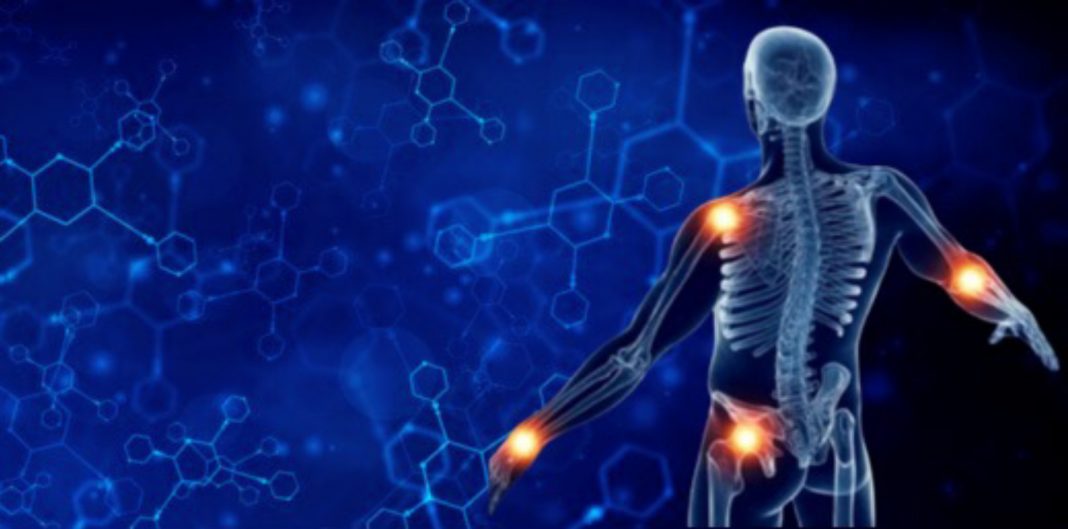Stephen Vanner, president of pHarm Therapeutics Inc., and Christoph Stein, inventor and co-founder, discuss a new class of analgesics for pain caused by tissue injury and inflammation
Severe pain resulting from major tissue injury and inflammation, such as arthritis, trauma, surgery, cancer, migraines, sickle cell crisis, and inflammatory bowel disease, can often only be treated effectively with conventional opioid medication. However, the risks of addiction and serious side effects, such as life-threatening respiratory arrest, have led to an opioid crisis in North America and worldwide.
The 2018 USA Federal Drug Administration roadmap to combat this crisis states that ‘transitioning from the current market, dominated by conventional opioids, to one in which opioids have abuse-deterrent properties, holds significant promise for a meaningful public health benefit.’ However, so far, competitive approaches, including biased opioid agonists, have failed.

How NFEPP targets pain originating from injury and inflammation
We have developed an entirely new approach that circumvents the risks of conventional opioids. Our prototype pH-sensitive drug, NFEPP, short for (±)-N-(3-fluoro-1-phenethylpiperidine-4- yl)-N- phenyl propionamide, is only active in injured and inflamed tissues where pH is low but not in healthy tissues elsewhere in the body, such as the brain and GI tract, where pH is normal (i.e., pH 7.4) (Figure 1).
Our preclinical studies, conducted in models of arthritis, colitis, post-operative pain, and cancer, have been externally validated in multiple independent laboratories. These studies have consistently shown that NFEPP has comparable analgesic potency to conventional opioids.
However, NFEPP lacks the addiction potential and central effects on the brain (see videos), as well as the tolerance, constipation, respiratory depression, or locomotor impairment commonly associated with opioids.
These findings are supported by our experiments in human tissue and ongoing studies in non-human primates.
VIDEO 1 (above): VEHICLE
VIDEO 2 (above): NFEPP
VIDEO 3 (above): FENTANYL
Videos: Similar to control (vehicle) mice, NFEPP-treated mice are relaxed and exhibit normal exploratory and grooming behavior. In contrast, fentanyl-treated mice appear agitated, moving rapidly and clinging to the sides of their enclosure, with their tails unnaturally arched over their backs –signs of centrally-induced anxiety.
Bringing NFEPP to market
We aim to conduct Phase 1-2 clinical trials in the next three years, with an initial focus on managing post-operative pain in orthopaedic surgery. We will collaborate closely with industry partners and regulatory bodies to achieve this goal.
The global pain market is projected to grow from $71bn to $91bn by 2027. Our innovative compounds have the potential to provide tremendous societal and healthcare benefits by offering a valuable alternative to conventional opioids and NSAIDs for painful inflammatory disorders.
What experts are saying about this new class of analgesics
‘A particularly exciting and promising strategy’; ‘A revolutionary way of thinking in pharmacology’
(Behav Pharmacol 2020; 31:136-158)
‘A key advance’; ‘a pioneering approach to produce safer opioids’
(Expert Opin Ther Targets 2019; 23:315-326)
‘NFEPP is a promising candidate for patients with peripheral tissue damage across the spectrum of chronic pain syndromes’
(Curr Pain Headache Rep 2021; 25:46)
‘…Extremely interesting peripheral visceral antinociceptive agent’
(Gut 2022; 71:1-2)
References
- Spahn, V., et al., A nontoxic pain killer designed by modeling of pathological receptor conformations. Science, 2017. 355(6328): p. 966-969; http://www.doi.org/10.1126/science.aai8636.
- Pivotal study showing concept development/ validation and efficacy of pH-sensitive analgesic in arthritis and post-operative pain rodent models
- Baamonde, A. et al., A low pKa ligand inhibits cancer-associated pain in mice by activating peripheral mu-opioid receptors. Sci Rep, 2020.10(1):p. 18599; http://www.doi.org/10.1038/s41598-020-75509-4.
- Important study showing the efficacy of NFEPP in blocking pain in a rodent cancer pain model
- Jiménez-Vargas, N.N., et al., Agonist that activates the μ-opioid receptor in acidified microenvironments inhibits colitis pain without side effects. Gut, 2022. 71(4): p. 695-704; http://www.doi.org/10.1136/gutjnl-2021-324070.
- Crucial research demonstrating NFEPP’s efficacy in a rodent colitis model, with no respiratory, locomotor, or gastrointestinal side effects
- Degro, C.E., et al., Evolving acidic microenvironments during colitis provide selective analgesic targets for a pH-sensitive opioid. Pain 2023; 164: p. 2501–2515; http://www.doi.org/10.1097/j.pain.0000000000002956.
- Key study showing that tissue pH parallels the evolution of inflammation in a colitis model and that the pH-sensitive opioid analgesia is titrated to the degree of inflammation
- Stein, C., et al., Analgesic effect of intraarticular morphine after arthroscopic knee surgery. N Engl J Med, 1991. 325: p. 1123 1126; http://www.doi.org/10.1056/NEJM199110173251602.
- Seminal study revealing that the activation of opioid receptors in peripheral injured tissue produces clinical pain relief

This work is licensed under Creative Commons Attribution-NonCommercial-NoDerivatives 4.0 International.


